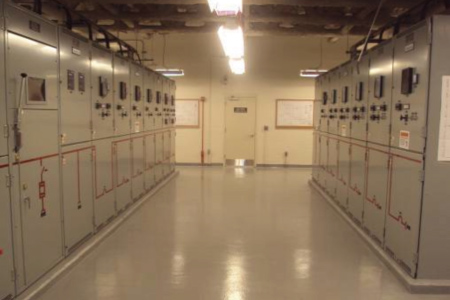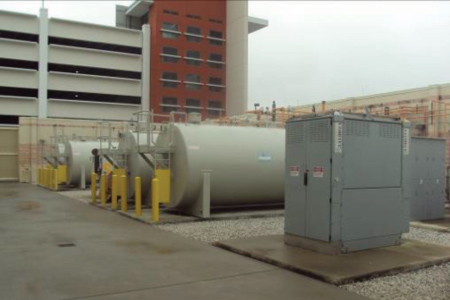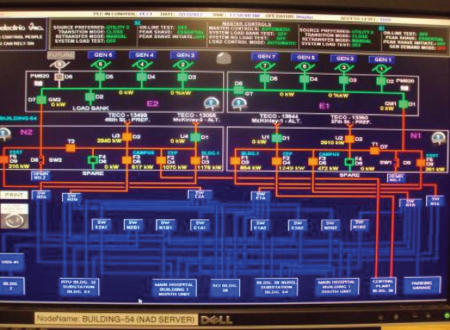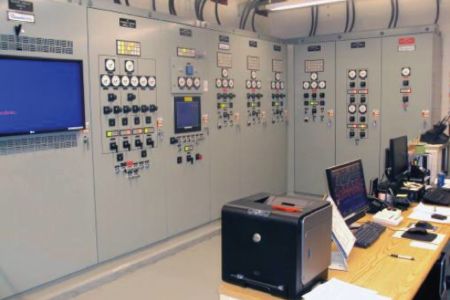Few if any hospitals have a better power system than the James A. Haley Veterans’ Hospital in Tampa, Florida, thanks to its recently renovated power plant. Completed at a cost of $47 million, it includes SCADA and a backup system capable of covering all electrical loads for 120 hours (without refueling) in the event of an outage.
A teaching hospital affiliated with the adjacent University of South Florida College of Medicine, Haley Hospital provides a full range of patient services with state-of-the-art technology and research. It has 548 beds, plus another 118 beds in an on-site long-term care and rehabilitation facility – the Haley’s Cove Community Living Center. The busiest of four U.S. Veterans Administration (VA) polytrauma facilities in the nation, Haley serves a four-county area in which it also runs four outpatient clinics.

James A. Haley Veterans’ Hospital in Tampa, Florida, boasts one of the most advanced
emergency backup power control systems of any hospital in the United States.
After Hurricane Katrina hit New Orleans in 2005, the VA called for bids to upgrade emergency/backup power systems at VA hospitals in hurricane zones – upgrades that could ensure continuous air conditioning, not just the operation of life-safety and other critical equipment.
For Haley Hospital, the winning bid for power control switchgear, transfer switches, and SCADA was from Russelectric, a well-known power control firm based in Hingham, Massachusetts.
Extra Layer of Confidence
The hospital’s administration is pleased with the new power system, which provides many more capabilities than the previous one. Although there has not been an unexpected utility outage since the system became fully operational in May 2010, Byron Taylor, the hospital’s Lead Power Plant Operator, appreciates the extra layer of confidence. At Taylor’s side to oversee the system, as they were throughout the planning and installation process, are Engine Technician Kyle Graley and Electrical Shop Supervisor Bill Hagen.

One of two rooms housing the medium voltage generator/utility switchgear
“We’ve had some storms come through, and it has been really nice because we do not have to worry,” says Taylor. “One time, we saw the storms coming and Tampa Electric Company (TECO) asked us to drop off the grid. We fired up our generators, and operated on our own power for 17 hours, while TECO concentrated on restoring power to its residential customers. That sort of thing has happened several other times for shorter periods, and there has never been a problem.”
Hagen particularly appreciates the quality of the power from the backup system. “We get more blips from TECO than we do from our system,” he quips. “It is exceptionally smooth.”
The hospital’s former backup power system included nine on-site generators, yet it could only cover life-safety loads – 45 percent of the hospital’s total load – in the event of a utility outage. Hagen has no fond memories of the old system, which he calls ‘a major headache,’ least of all for the system’s dynamic matrix control. “We had nothing but problems with it,” he recalls. “We never got it to work in parallel. It couldn’t even generate a monthly testing report.”
In contrast, the new backup system covers everything – every load for nine buildings, 15 trailers that make up an on-campus clinic, and a parking garage – with just seven new 13,200-VAC Caterpillar diesel generators that produce 2,200 kW each.
Another improvement is the hospital’s renovated fuel system. The former system had a capacity of 22,000 gallons, and the storage tanks were spread out over several locations. Today, a new tank farm has four 12,000-gallon tanks. With another 6,000-gallon tank under each generator, the system has a capacity of 90,000 gallons.

With full tanks, the hospital has enough fuel for 120 hours of backup power if utility feeds are lost.
The 2-MW load bank in the foreground facilitates testing of generators.
More improvements are in the works. As of now, Haley Hospital receives no rebates or preferred rates from TECO, and the agreement between the entities does not allow the hospital to feed power back to the grid. But that agreement could change someday. On the roof of a parking garage, the hospital will be installing photovoltaic (PV) cells expected to generate another 500 kW of power. Newly installed solar panels in the adjacent parking lot near the long-term care facility (Haley’s Cove) will supplement that building’s utility feed by up to 500 kW. The new cells will boost Haley’s photoelectric output to a total of 1 MW, enough to illuminate two parking lots. Although feeds from the solar panels are lost when the hospital’s generators take over, under everyday conditions the new panels might provide surplus power that would enable the hospital to sell some power back to TECO. A peak-shaving arrangement with the utility is also likely in the near future, according to Taylor.
The Power of Information
Very important to the power control system upgrade is the new state-of-the-art SCADA system, which includes software and screen displays customized for the hospital’s needs. It provides interactive monitoring, real-time and historical trending, distributed networking, alarm management, and comprehensive reports around the clock for every detail of the entire power system, not just for the backup components.

SCADA screen displaying a one-line diagram of the state-of-the-art power system

One of two panel boards in the control room at the hospital’s power plant. The boards Include
a custom SCADA system that allows remote monitoring and control of all aspects of the hospital’s
power system and provides extensive information for analysis and planning. Operators normally
access the system through desktop workstations.
In addition to monitoring power quality, the SCADA system’s many functions include continuous monitoring of fuel consumption by each generator and the level of fuel in every tank. An operator can easily monitor and control the facility’s entire power system using full-color ‘point and click’ interactive computer-screen displays at the system console. For example, the operator can access and change the system’s PLC setpoints, display any of the analog or digital readouts on switchgear front panels, run a system test, or view the alarm history. A dynamic one-line diagram display uses color to indicate the status of the entire power system, including the positions of all power switching devices.
Operating parameters are displayed and updated in real time; flashing lights on the switchgear annunciator panel also flash on the SCADA screen. Event logging, alarm locking, and help screens are standard.
“The SCADA is so sensitive that it detects and explains even the slightest anomaly, including those in the utility feed,” says Taylor. “A number of times we’ve called TECO because we saw something happening, and they had no idea they even had a problem yet! The stuff the system does is phenomenal. It gives us more data than we ever need for an average day, but it’s tremendous that we have it when we do need it.”
By John A. Meuleman
As with the installation at the James A. Haley VA Hospital, Russelectric custom designs and builds high-integrity power control systems to meet the stringent performance and reliability requirements of data centers, airports, hotels, communication hubs, banks, defense installations, and other mission-critical facilities.
Designed to maximize uptime during normal source disruptions or aberrations, these systems provide emergency generator control, synchronizing, and distribution. They can accommodate open- or closed-transition transfer in sophisticated control schemes such as utility paralleling, peak shaving, and load curtailment. Prime power and cogeneration systems are also available.
Custom SCADA provides system integration and remote supervisory control through highly detailed, full-color monitoring screens. Simulation software is available for diagnostic testing, system verification, and off-line operator training. Russelectric also offers a full line of automatic transfer switches and bypass/isolation switches, including the industry’s most comprehensive line of UL tested (per UL 1008), listed, and labeled 30-cycle-rated switches, which dramatically simplify selective coordination of overcurrent devices. Switches have the industry’s highest UL 3-cycle close and withstand ratings.
All transfer switches and bypass/isolation switches are controlled by the advanced RPTCS controller, the industry’s most powerful, most versatile microprocessor-based transfer control system.
The company’s single-source approach is based on pre-specification support and assistance; individual project engineer responsibility/supervision from system design through installation; and totally integrated manufacturing for quality assurance and continuous parts availability. Strategically located throughout the United States, knowledgeable factory-trained Russelectric field-service engineers are on call 24 hours a day, 7 days a week.
Founded in 1955, the company has been employee-owned since 2010. While Russelectric will never compromise on quality, the company will go out of its way to provide exactly what customers want.
About the Author
 John Meuleman is Vice President of Russelectric Inc. Mr. Meuleman has over 30 years of experience in emergency/backup power systems for mission critical facilities. He holds a degree in electrical engineering and is a member of the IEEE, AEE, 7x24 Exchange, and NFPA. Contact http://www.russelectric.com/
John Meuleman is Vice President of Russelectric Inc. Mr. Meuleman has over 30 years of experience in emergency/backup power systems for mission critical facilities. He holds a degree in electrical engineering and is a member of the IEEE, AEE, 7x24 Exchange, and NFPA. Contact http://www.russelectric.com/
Freedom to Test the System
In accordance with state and federal regulations, the backup generators are tested every month. Thanks to the new system’s capability for closed-transition transfer, the tests inconvenience no one. Because there is no interference with hospital loads, there is no ‘blip’ (power interruption).
The system allows Taylor and Graley to carry out the tests in two different ways. They can parallel the output of all seven generators to the utility feed, or they can test one generator at a time up to its full output, by way of a special 2-MW load bank that has an independent control panel. Testing can be initiated manually or through SCADA. “It’s so much easier now,” says Hagen. “We’ll never again have to pay a testing firm to come out and test an engine to make sure it meets all the requirements.”
Unlike most hospitals, Haley has the advantage of four utility feeds. On a normal day, it draws from two of these (primary) feeds. This means that, except for testing, Haley does not have to start its generators until it loses three or more utility feeds.
With advance notice from the utility that an outage is likely, Haley’s power plant personnel can now parallel the utility feeds with their own generators, then switch to on-site power seamlessly (closed-transition transfer). But if there is an unexpected outage (and when the automatic transfer switches are tested), there will be a ‘blip’ of 1 to 10 seconds, depending on the load. For life-safety and other critical loads, the ‘blip’ is only 1 to 3 seconds. ‘Blips’ for other loads are adjustable; most are set for 8 to 10 seconds.
Technical Support
Taylor and Hagen have high praise for the supplier’s field support services. They recall working hand-in-hand with Jim Bourgoin, the company’s local Field Service Engineer, for seven months.
“During installation, Jim helped the contractors interpret the design whenever they were puzzled,” Hagen says. “Afterwards, he stuck around to help us get things up and running. It took a lot just to understand everything this system can do. I already had a background in this, but it took quite a bit of training to really get up to speed.”
Taylor recalls, “There has not been one time when I have called Jim for an alarm or with questions about the system – whether at midnight or later – that he didn’t answer the phone and help me. And on two occasions, he drove here at 3 or 4 in the morning to correct something that had gone wrong. But it’s not just his responsiveness that’s impressed us. The service he provides is exceptional, and it has been that way since day one. To me, that’s worth just as much as the system itself.”
Taylor adds that Tom Crider, the local sales representative, was also deeply involved throughout the project, answering questions, facilitating the installation, and training Taylor’s staff. Recently, with Taylor’s cooperation, Crider has led personnel from two other Tampa hospitals on tours of Haley’s power system. One of those hospitals is installing a similar system. The other is considering such an installation.
Onward and Upward
The fact that the system is designed to allow for modifications as the hospital continues to grow has Taylor thinking. “With this new power system, we have seen what is possible,” he notes. “It provides us with the information we need to analyze our power usage and consider new possibilities – opportunities we never would have considered before.”
About the Author
 Ben McKelway writes for Norris & Company, a specialized industrial advertising and public relations agency with a clientele of manufacturers whose wide-ranging product lines include adhesives and materials-handling equipment in addition to electrical switches, switchgear, and emergency/backup power systems.
Ben McKelway writes for Norris & Company, a specialized industrial advertising and public relations agency with a clientele of manufacturers whose wide-ranging product lines include adhesives and materials-handling equipment in addition to electrical switches, switchgear, and emergency/backup power systems.








